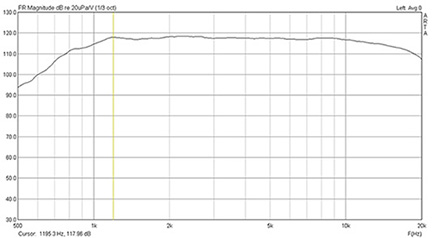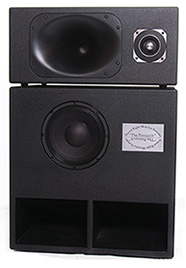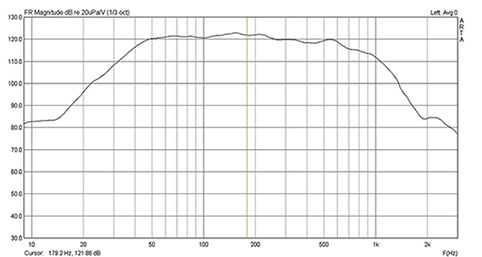Reviews
Read what some of the leading reviewers said about some of
David’s designs!
the amount of low bass energy
this speaker can produce is astounding..
is up there with the
established big boys, ATC, Genelec, PMC and the rest..
Hugh Robjohns
..an optional, I would
suggest imperative extra is on site analysis and alignment of the
system..
the
results were most impressive, exhibiting delicacy and presence
conveying the subtle detail..that few boxed loudspeakers can equal
Ivor Humphreys
"there
was absolutely no hint of either compression or distortion, just
limitless power coupled with lightning speed"
David Allcock
Other Links
Peter Mapp article
and others, Look here.

|
The performance of the Patriarch is realised through a combination of sound design principles, rugged cabinet construction, careful driver selection and accurate control of the system.
Each drive unit has been chosen for their specification and value. The bass unit (not visible!) and midrange are sourced from Beyma, the horn from Faital fitted with a P Audio neodymium driver and the bullet is a “high end” IMG ring radiator with a titanium diaphragm which extends the response to 22kHz matching the efficiency and dispersion of the Faital horn. The elliptical tractrix horn combines a lower cut off frequency and distortions when compared to other horn profile types. |
Maximum performance of the Patriarch system is achieved by accurate driver control and this is best managed with DSP for each section.
Although the crossover points may be applied with an analogue active crossover it is not possible to time align the system using this method. The final crossover points selected by this designer are 250/930/8000Hz with 24dB/octave Linkwitz Riley slopes. Some eq will almost inevitably be required to flatten the system for accurate monitoring purposes but even without the Faital horn/driver combination and bullet are substantially flat in response.
The bass end with their sealed cabinets and the small horn loading effect of the cabinet mouth produce deep tight bass with very low group delay and superb control. The trade off is a slightly earlier roll off than bass reflex designs but with much better control and power handling at low frequencies. Their Qt is a Butterworth of .71. Some eq bass lift is easily applied and be assured, these bass units kick!
|
| This plot shows the response of the bass and midrange unit. The plot was achieved by placing the microphone millimetres from the baffle between the midrange and bass “mouth”. Some bass lift has been applied and the crossover
(Low Pass) is a 24 dB/octave Linkwitz Riley |
 |
| This is the response at 1metre on axis from the midrange, Faital horn and bullet. This was measured “in room” with ARTA and a Behringer microphone. A similar result is achieved with the True Audio RTA “chirp”. Note how the time alignment when combined with Linkwitz Riley networks achieves a virtually flat response through the crossover points. |
With Sound Right offering to set up the Patriarch Studio Monitor system you are assured of an optimised loudspeaker capable of delivering a dynamic high resolution performance at live levels. The flat response achievable with time alignment and steep crossovers combined with the level of detail reproduced enables the engineer to hear right into the mix and create their best work!
The optimal Patriarch Monitor system will require eight active channels and if time alignment is implemented DSP loudspeaker management is mandatory. The time alignment required may be calculated using the Step response feature on programmes such as the superb ARTA software and EQ may be applied of course to each channel with the chosen loudspeaker management system.
Another benefit of the active approach for each channel is if the Patriarch monitor is the loudspeaker of choice for the domestic high end user who wishes to choose more esoteric high frequency units that extend the response to 30Khz+. These additional tweeter units may be placed on the top cabinets on the vertical axis of the Faital horn and replace the ring radiator bullet. Two “esoteric” super tweeters that come to mind are the Fostex 90A and the Visaton TL16, but be prepared to add some more to your budget!! There is also the option to change the P Audio compression driver for a BMS Coaxial model eliminating the need for a tweeter completely but again these units are very expensive.
Sound Right always attempts to achieve the maximum performance for it’s customers at a sensible budget with proven drivers that offer superb reliable performance at a real world price.
Esoteric drivers alone do not necessarily create a better sound if attention has not be paid to the quality of the cabinets and the integrity of the complete design. With the Patriarch monitor homage is paid to the laws of physics! Aligning the acoustic centres of the midrange, Faital horn and bullet with delays, crossing over at frequencies well within the operating range of each unit and judicious application of eq where required combine to produce a product entirely suited to it’s application.
Clean, detailed, low distortion and capable of levels in accordance with studio monitor requirements, you may do well to consider the Patriarch for your monitoring system!
 |

